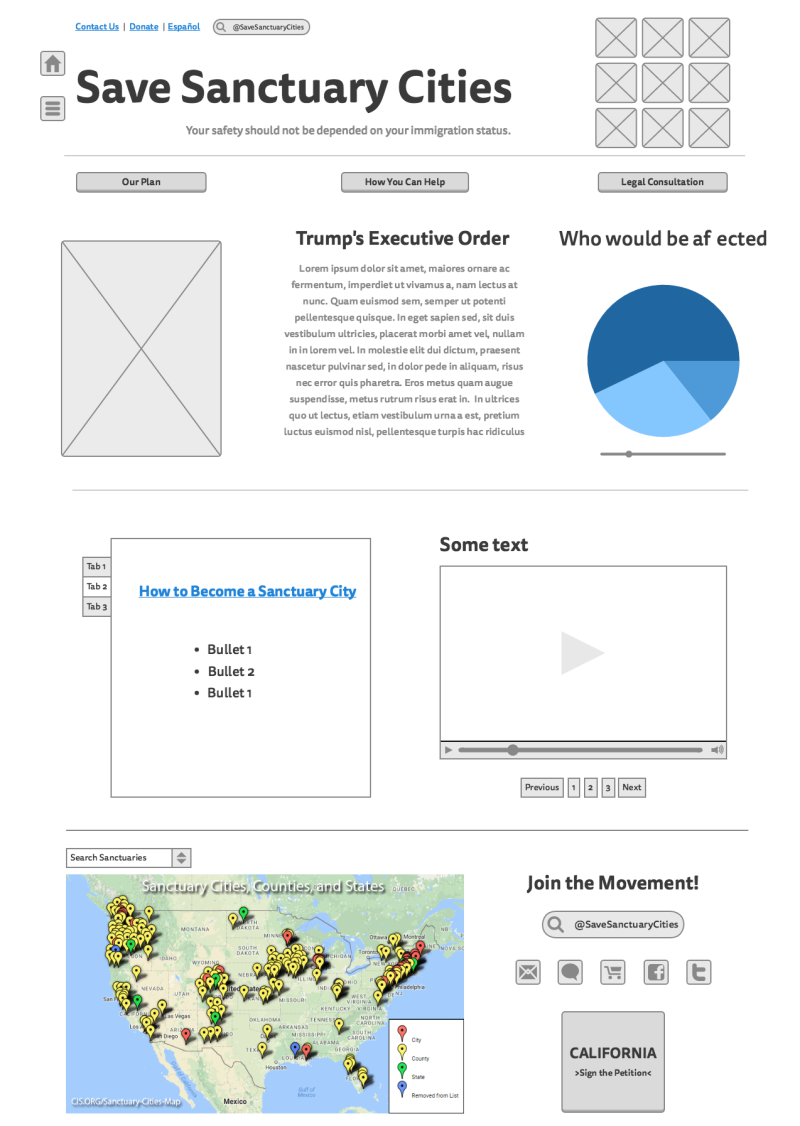by Carlos Rodríguez and May Liu
Abstract
Sanctuary cities will play a tremendous role in the years to come in the United States because what they represent for this country not only economically but also socially. While not to gloss through the 11 million immigrants that might be deported, the true battle is Trump’s aggressive federal government against State’s rights, which is the essence of our country. Sanctuary cities must remain as such in order to keep a rightful balance between the state and federal government.
On January 25th, President Trump signed an executive order stating that any city that continues to be a “sanctuary state” will be defunded. If these cities and in some cases whole states like California continue to reject Trump’s orders, they could lose billions of dollars in funding. The problem is, “Sanctuary cities” has no actual legal presence. All a sanctuary city is is a city and its local law enforcement and officials that do the absolute bare minimum when dealing with federal organizations and agents like ICE (immigration and Customs Enforcement). Trump and his administration is trying to threaten sanctuary cities by defunding them through Homeland Security’s US Code Title 8, section 1373 that states: “Notwithstanding any other provision of Federal, State, or local law, a Federal, State, or local government entity or official may not prohibit, or in any way restrict, any government entity or official from sending to, or receiving from, the Immigration and Naturalization Service information regarding the citizenship or immigration status, lawful or unlawful, of any individual.” While this does seem straightforward, this title has already lost some legal cases. Because Trump wants to punish these cities for non-cooperation fiscally, he wades into a muddy legal area where his side has already lost before. The only way his order could financially punish these sanctuary states and cities is if it his mandates were “unambiguously stated in the law of text”. Pennhurst State Sch. & Hosp. v. Halderman 451 U.S. 1 (1981), a supreme court case set precedence that grants can only have financial conditions if the text has been confirmed unambiguous by the cities and states to make it explicitly clear the grounds on which they are accepting the financial aid. However, this Supreme Court precedent automatically pushes the argument to the next court case Printz v. United States (1997), which stated that the 10th amendment does not allow for the federal government to force the state to have to comply with the federal government through essentially fiscal blackmail. It is worth noting that Judge Antonin Scalia, who was a very conservative Supreme Court judge, supported Printz v. United States.
Now the issue is how can we as citizens help undocumented citizens before all of what was mentioned above happens? Until the cities and states go to court and win, many undocumented citizens will still be helpless. My hope is to at least build some sort of website that can help them understand what to do if they are ever under arrest for a non-felonious crime, hoping to be let go before ICE can deport them.
Wireframe


Plan for Action
Introduction
How come undocumented immigrants are only becoming such a big issue now? The answer is they are not. There have always been voices, like President Trump’s, who raised concerns against undocumented immigrants. But since Trump was elected president and his one of his campaign promise is to enforce much stricter immigration laws – which includes suspending immigration from terror-prone regions, building a wall between the United States and Mexico, deporting undocumented immigrants, and many more – the fear of not being able to stay in this country because of one’s immigration status is coming closer to reality. It is hard to determine whether he would follow through with all of his promises, but he had already signed the executive order barring people from seven countries that are “terror-prone” from entering. While one of his executive order has been overturned, we must stay vigilant and proactive to make sure millions of people are not deported. Our mission is to create a website that contains as much vital information to help undocumented people and those who already are citizens to help protect those who can’t protect themselves. We would do this by showing maps, statistics and redirecting to other organizations and resources that might be better equipped. Lastly, this website should try and assist as much as it can in legal aid and to appeal to municipalities and states to help all who live within their cities and states.
To protect immigrants, many cities across the U.S. have declared themselves as sanctuary cities, in which police officers do not arrest people for being an illegal alien and the local government does not abide, or makes minimal effort cooperating with federal immigration authorities. The protection from sanctuary cities are now more important than ever, that is why it needs help from everyone. As promised, Trump signed an executive order in the first few days of his presidency to deny federal funding to sanctuary cities. Although it is still being debated whether that order is constitutional, it poses even more danger for immigrants all over the country. Immigrants would need better access to sanctuary cities and legal representation. The goal of this campaign is not to start anything new, but to preserve and expand what is already there.
What this campaign needs are donations/funding
Immigrants, even legal ones who have been in the country for years, could face deportation from any interaction with the criminal justice system. Since immigration is part of civil court, attorneys need not be assigned to the defendant, and a lot of the time they cannot afford to hire one themselves. The result of that is they never know they could challenge the deportation, or they accept it without knowing the conditions of their deportation. New York City’s Immigrant Public Defender Program that started in 2014 has been providing attorney representation in court for immigrants in need, especially cases that might tear families apart. The program helps hundreds of cases in New York and New York residents held in New Jersey. With an estimated number of 11 million undocumented immigrants and a total of approximately 61 million immigrants in the U.S., this program needs to exist in a lot more, if not all sanctuary cities across the country. Our website, which would need to be translatable into different languages so what it can help undocumented people seek help in regards to finding some legal assistance. Legal assistance would be the biggest help to immigrants here and finding a way to afford it is the first priority. The best way to do that is to have our website show our visitors who need it to understand all of their legal recourses and try to persuade municipalities that have pledged to stay sanctuary cities, like New York City, which used 4 million dollars to help fund those who can’t afford representation, and our website can show them that they can get legal representation instead of assuming that because they have been arrested it’s an automatic deportation.
Sanctuary cities do not have a true definition, but there are steps that a city or township could take to become a safe haven for immigrants. Although there are hundreds of sanctuary cities, they protect immigrants to different extents legally, as there are seven sanctuary policies a local government can enforce to limit cooperation with the U.S. Immigration and Customs Enforcement [ICE], which lowers immigrants’ chances of getting on their radar (Lena & Marquez, 2016). Our website would show all sanctuary cities and color code them based on how much policy they have for protection so someone would make better informed decisions on where to move.
- No ICE holds – this means local law enforcement agency cannot hold people upon ICE request so they can come take custody after they should be released
- No 287(g) – 287(g) makes the ICE’s job the city or county’s, which should not be. Not following it preserves resources for local priorities.
- No ICE detention or contract – county jails cannot be paid to hold immigrants who are in their deportation process.
- No ICE alerts – they cannot alert ICE when a particular person is being released.
- Limits on ICE in local jails – ICE agents cannot enter certain parts of the jail without a warrant or they cannot interrogate immigrants in the jail.
- Prohibitions on inquiries into immigration status and/or place of birth.
- General prohibitions on use of resources to assist ICE.
Most cities do not have all seven policies in place, but most laws are depended on the county when it comes to immigration, so it is the biggest step to take to becoming a sanctuary city.
A way to spread awareness and information to the largest number of people would be a website. Our website would have different links for different situations. For instance, there would be a small map that shows all sanctuary cities within California or the United States. Furthermore, the website would have information on certain legislation that is currently being discussed or created that will keep citizens and undocumented immigrants informed and try to help them accordingly. The website would also talk about certain statics and make sense of them. The website would keep people informed with the DREAM Act and DACA seeing as many families have different family member fall into those issues. Again, if this website is able to be translated into other languages like Spanish, it would help undocumented immigrants stay informed as well seeing as they perhaps need this information most. It must be made clear what type of legislative information and or suggestions the website makes. We would use money to pay a specialized attorney to make sure our website helps without wading into legal repercussions.
Another action that would be paramount is to have this website and its creators pay an attorney to help create a petition like the California Senate Bill 54 or a petition for a pilot program like in New York and Los Angeles, and have our website redirect our page visitors to have them sign it to raise its awareness to our politicians. In California Senate Bill 54 has already passed one committee, although it needs to pass two more to reach the Senate Floor. But if this bill passes, it would solidify legally many of the optional recourses mentioned earlier and prevent local and federal officers from collecting someone’s immigration status and require ICE agents to obtain a judicial warrant in order to hold someone in custody for longer. Now, if someone who might be undocumented is pulled over, they don’t have to worry about being arrested for being undocumented. As long as they don’t mention it, neither will local and federal law enforcement.
The most important issue would then be having undocumented citizens who might have trouble finding all of this information that will protect him learn it. Our hope is that this website can spread this information accurately and effectively that other websites and organizations that do have access to the larger undocumented population online like certain Mitu that have multiple platforms across social media that they will mention and discuss our plans and content in order to share this crucial information to them and show our local and federal government the growing seriousness of the issue.
References
Graber, Lena & Marquez, Nikki. “Searching for Sanctuary An Analysis of America’s Counties & Their Voluntary Assistance With Deportations.” Immigration Legal Resource Center, December 2016, p. 8.
